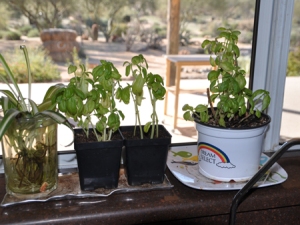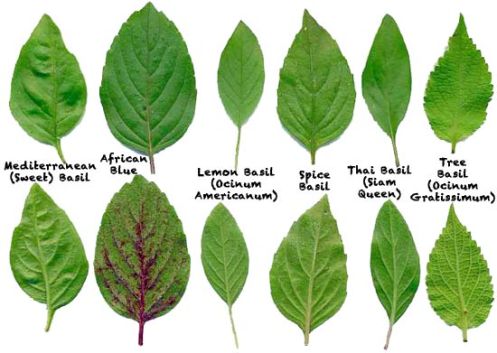Growing Varieties of basil in your garden or windowsill
 Basil originates from tropical regions in India and is a plant that enjoys a large amount of sun. Basil grows as a perennial in India but is a tender annual in cooler climates.
Basil originates from tropical regions in India and is a plant that enjoys a large amount of sun. Basil grows as a perennial in India but is a tender annual in cooler climates.
If you are growing basil in your herb garden or growing basil on your windowsill, you will find that you never run out of ways in which you can incorporate basil into your everyday life.
In fact you will probably find that you are not growing enough basil to keep up with your demands.
Growing basil from seed
Sow the seeds in spring in seed trays and keep indoors or in a heated greenhouse until the seedlings reach the four-leaf stage. Keep well watered at all times whilst the seedlings are growing.
The seedlings can then be easily handled and transplanted out into pots or containers or directly into the garden in a well drained soil, where they can continue growing with the benefits of all the nutrients from the soil.
Plant the seedlings 20 inches apart and keep shaded for the first few days and water regularly.
Conditions for growing basil
Although basil likes sun, it must be planted in a sunny, sheltered spot away from wind and draughts.
Don’t plant basil until all risk of frost has disappeared. During midsummer basil likes semi-shaded growing conditions.
Growing basil in the garden
Growing basil between tomatoes and other vegetables in the greenhouse or garden will benefit both the basil and the other vegetables.
Basil will enhance the flavors of the other vegetables growing around it and will also deter insects.
Growing basil in your garden will attract bees and butterflies if planted outside.
Growing basil under glass in a cool summer is a good way to ensure a lush and healthy plant and supply of leaves. Remember though, if you are growing basil in your garden, you should not plant it next to rue.
 Growing basil in the kitchen or greenhouse
Growing basil in the kitchen or greenhouse
Basil can quite easily be grown inside as long as it has a light and sunny spot on the windowsill or shelf in the greenhouse. If you keep the plants indoors you should be able to keep your basil growing well into the cooler months.
Harvesting Basil
Once the basil has grown to a height of about 5 inches, you can start to take off the top sets of leaves. Pinch them out to the next set of leaves growing below. This will ensure a continual growth and should encourage a healthy, bushy basil plant.
Prune your basil every 2 or 3 weeks to ensure a healthy bushy plant.
Basil will continue growing throughout the summer and can ultimately reach up to 24 inches(2 ft) in height. If the basil is left to flower, it will produce long spires of small, white tube shaped flowers.
To encourage a supply of leaves throughout the summer and autumn, pinch out the buds as soon as they appear.
Basil Foliage
Depending on the variety of basil you are growing, the juicy, oval leaves will grow up to 4 inches in length and will be a glossy rich green. Basil is highly aromatic with a strong scent reminiscent of cloves.
Basil plants will cross pollinate very easily so if you are collecting and planting your own seeds year after year, you should notice some slight variations which makes growing basil an interesting hobby and pastime.
 Different varieties of basil herbs
Different varieties of basil herbs
- Bush basil – ocimum basilicum var. minimum … This variety of basil has small leaves and is more tolerant of different growing conditions. It can also be grown in a pot. Its also an annual but only grows to about 5 inches in height. This variety of basil can be used for culinary purposes.
- Camphor Basil – ocimum basilicum var. kilimandscharicum … This variety of basil was named for Mount Kilimanjaro and can be used medicinally as a tea for colds and stomach ache. It’s ideal for clipping making it versatile enough to be trimmed into a small hedge or topiary.
- Zulu basil – ocimum basilicum var. urticifolum … This variety of basil has lemon-scented leaves.
- Purple Basil – ocimum basilicum purpureum … This variety of basil has dark purple leaves and pale pink flowers and is mainly used as an ornamental plant.
- Purple Ruffles Basil – ocimum basilicum ‘Purple Ruffles’ … This is a very attractive and unusual ornamental variety of basil with ruffled edges to the maroon leaves.
- Green Ruffles Basil – ocimum basilicum ‘Green Ruffles’ … Another ornamental variety of basil similar to ‘Purple Ruffles’. Again leaves are ruffled and this variety has lime green leaves.
- Lemon Basil – ocimum basilicum var. citriodorum … This is another lemon-scented variety of basil and is generally smaller and a more compact plant.
- Sacred Basil – ocimum basilicum ‘Sanctum’ … Hindu’s regard this variety of basil as sacred and as such it is used in worship. The leaves are gray-green and coarse and it has lavender flowers.
- Perennial Basil – ocimum basilicum var. gratissimum … The leaves of this basil variety can grow up to 5 inches in length. This variety is classed as a shrub and can grow up to 6.5 ft. in height.
- Lettuce Leaf Basil – ocimum basilicum var. crispum … A large-leafed variety of basil that is ideal for salads and has crinkly leaves and white flowers.
- Thai Basil – ocimum basilicum ‘Thai’. This variety of basil has a slight liquorice flavor and aroma and is used in many oriental dishes.

Trackbacks & Pingbacks